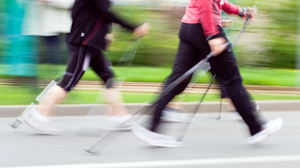

Some years ago, while exploring a safe mode of exercise for her parents, who were both dealing with health issues, Dr. Agnes Coutinho, Assistant Program Head of Kinesiology, came across the activity of urban poling (also known as Nordic walking).
Her parents tried the activity at Dr. Countinho’s insistence. Now, five years later, they participate in urban poling regularly and even carry the collapsible and lightweight poles with them on vacations.
Witnessing first-hand the rehabilitative benefits of urban poling led Dr. Coutinho to embark on several research projects, including a study funded through UofGH’s Research Grant Fund, “Walk Away Stress: Urban Poling." The study was designed to determine if urban poling was a suitable and effective fitness program to address the well-being of University of Guelph-Humber and Humber College employees during the workday within the workplace setting.
Urban poling is an activity where walkers of all ages and abilities mimic cross-country skiing motion with the help of specially designed, ergonomic poles, minus the skis. The poles are equipped with special tips or “booties” making this activity suitable for different terrains.
“There are many research studies that show the significant mental and physical health benefits of urban poling,” said Dr. Coutinho, who is a Board director and Past Chairperson of the National Aboriginal Diabetes Association and was responsible for developing a diabetes-focused walking program for the organization. “The common thread in each of the studies is that the dropout rates in urban poling groups are low compared to other physical activities, meaning urban poling participants are more likely to adhere to their exercise programs. That to me is the real driver of why this mode of physical activity is so successful.”
Each walker plants the poles with each stride in order to propel themselves forward. The activity engages the upper body, including arms, shoulders and the core muscles resulting in the body to burn an average of 20 per cent more calories than walking without the poles, Dr. Coutinho explained.
“With pole walking, you are working a lot harder than you think,” she said. “As you do it for longer periods, you will see those benefits.”
When Cristina Miceli, a fourth-year Kinesiology student and a certified Urban Poling instructor, introduced this activity to a group that had never heard about it before, many were skeptical at first.
Fifteen minutes into their walk, the walkers were sweating profusely from the workout. They revised their initial opinion and gave urban poling definite thumbs up.
“Urban poling is a type of activity that people, regardless of their fitness level and age, can easily do,” Miceli said. “By simply adding the poles into your walking, you will be activating many of the major muscle groups in the body. Every kilometre you walk, you are working your core with an equivalent of 1,000 abdominal contractions.”
Nordic walking as an activity can be taken all year long and across all terrains.
Six reasons to take up urban poling
- Increased cardio-vascular activity burning between 20 per cent to 46 per cent more calories than walking without poles
- Uses most of the muscles, including the upper body and the core muscles that are generally not used when walking
- It’s a fun social activity for most
- Can be done on all types of surfaces and all year round including the winter
- Equipment is inexpensive and technique is easy to learn
- Has many physical and mental health benefits







